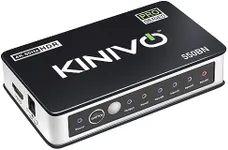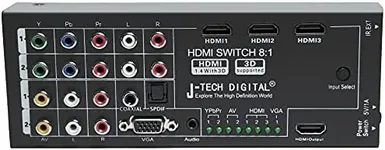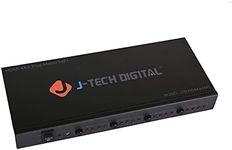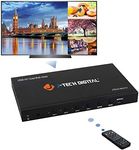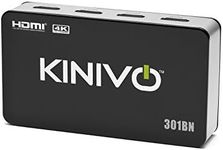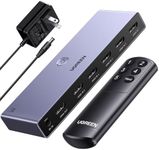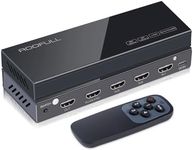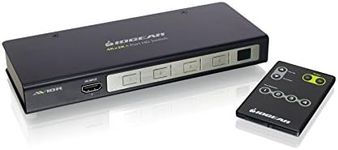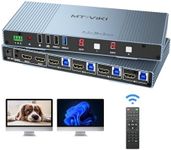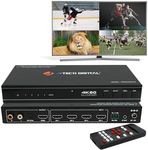Buying Guide for the Best Hdmi Switchers
HDMI switchers are devices that allow you to connect multiple HDMI sources to a single HDMI input on your TV or monitor. This is particularly useful if you have more devices than available HDMI ports on your display. When choosing an HDMI switcher, it's important to consider several key specifications to ensure it meets your needs and provides the best performance for your setup.Number of PortsThe number of ports on an HDMI switcher determines how many devices you can connect to it. This is important because it directly affects how many HDMI sources you can switch between without having to unplug and replug cables. HDMI switchers typically come with 2, 3, 4, or even more ports. If you have a few devices, a 2 or 3-port switcher might be sufficient. However, if you have multiple gaming consoles, streaming devices, and other HDMI sources, you might need a switcher with 4 or more ports. Consider the number of devices you currently have and any future additions when choosing the right number of ports.
Resolution and Refresh Rate SupportResolution and refresh rate support indicate the maximum video quality the HDMI switcher can handle. This is crucial for ensuring that you get the best possible picture quality from your devices. Common resolutions include 1080p (Full HD), 4K, and even 8K, with refresh rates ranging from 60Hz to 120Hz or higher. If you have a 4K TV or plan to upgrade to one, make sure the switcher supports 4K resolution at the desired refresh rate. For gamers, higher refresh rates like 120Hz can provide smoother gameplay. Match the switcher's capabilities with your display and source devices to ensure compatibility and optimal performance.
HDCP SupportHDCP (High-bandwidth Digital Content Protection) is a form of digital copy protection to prevent copying of digital audio and video content as it travels across connections. This is important because many modern devices, such as Blu-ray players and streaming services, require HDCP compliance to display content. HDMI switchers typically support HDCP 1.4 or HDCP 2.2. HDCP 2.2 is necessary for 4K content, so if you plan to use 4K devices, ensure the switcher supports HDCP 2.2. If your devices are older and only require HDCP 1.4, then a switcher with HDCP 1.4 support will suffice.
Switching MethodThe switching method refers to how you change between different HDMI sources. This can be done manually via a button on the switcher, through a remote control, or automatically based on the active signal. Manual switching is straightforward but can be inconvenient if the switcher is not easily accessible. Remote control switching offers more convenience, especially if you frequently change sources. Automatic switching is the most seamless, as it detects the active device and switches to it automatically. Consider your usage habits and convenience when choosing the switching method that best suits your needs.
Power SourceHDMI switchers can be either powered or unpowered. Powered switchers come with an external power adapter and are generally more reliable, especially for longer cable runs and higher resolutions. Unpowered switchers draw power from the HDMI connection itself, which can be sufficient for shorter cable runs and lower resolutions. If you need a switcher for high-resolution content or have long HDMI cables, a powered switcher is recommended. For simpler setups with shorter cables and lower resolutions, an unpowered switcher might be adequate.
Audio SupportAudio support refers to the types of audio formats the HDMI switcher can handle. This is important for ensuring that you get the best audio experience from your devices. Common audio formats include stereo, Dolby Digital, DTS, and more advanced formats like Dolby Atmos and DTS:X. If you have a home theater system or soundbar that supports advanced audio formats, make sure the switcher can pass through these formats. For basic setups, stereo or standard surround sound support may be sufficient. Match the switcher's audio capabilities with your audio equipment to ensure compatibility and optimal sound quality.
